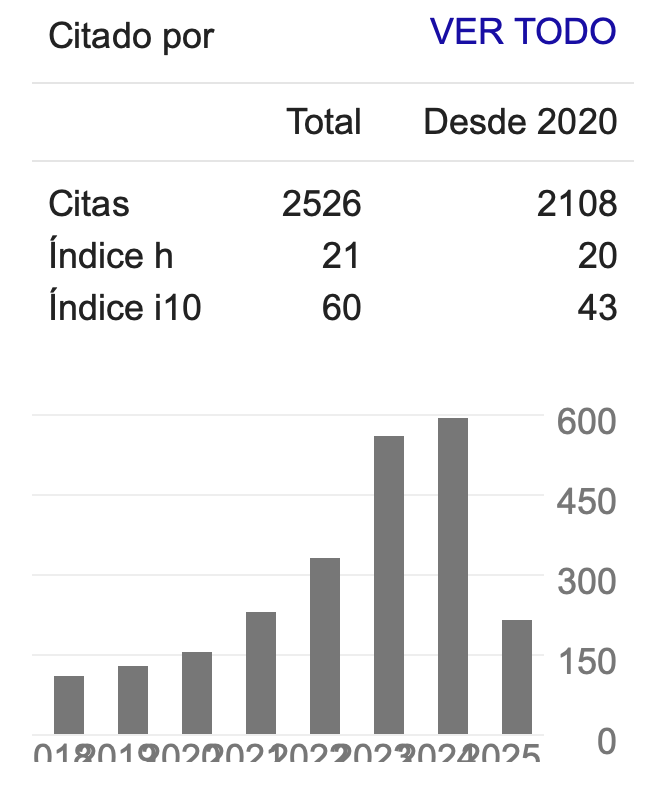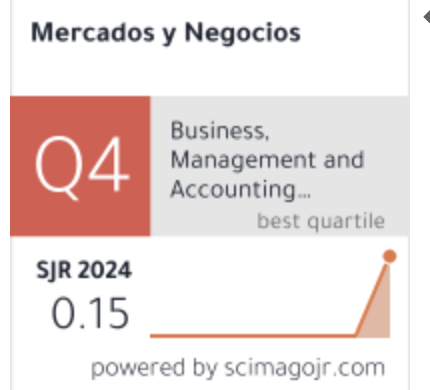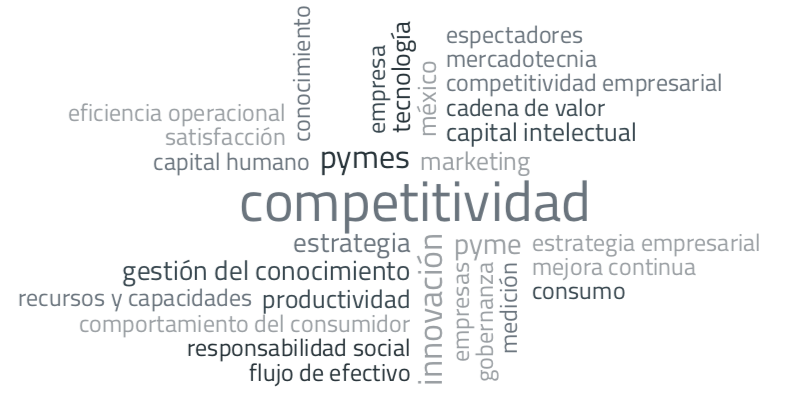The relationship between supply chain management and competitiveness
DOI:
https://doi.org/10.32870/myn.v0i31.4298Keywords:
Supply Chain Management, Competitiveness, SMEsAbstract
The globalization of the markets and the new business environmental are forcing organizations, mainly the small and medium-sized enterprises, to improve their competitiveness significantly since to remain in the current market it is necessary to modify the managerial strategies to adapt them to the changes and the clients’ requirements. In this sense, supply chain management appears in the literature like one of the managerial strategies that are implementing in important number of firms to be able increase competitiveness.Therefore, the essential objective of this paper is to analyze the relationship between supply chain management and the competitiveness of small and mediumsized enterprises, using for it a sample of 305 firms of the Aguascalientes State. The obtained results show that supply chain management has a positive influence in competitiveness level, as well as in the financial performance, cost reduction and the use of technology of the small and medium-sized enterprises.References
Academic Alliance Forum. (1999). “Future competition: Supply chain vs. supply chain”, Logistics Management & Distribution Report, 38(3): 20-21.
Acedo, F., Barroso, C., & Galán, J. (2006). “The resource-based Theory: Dissemination and main trends”, Strategic Management Journal, No. 27, pp. 621-636.
Anderson, J., & Gerbing, D. (1988). “Structural equation modeling in practice: A review and recommended two-step approach”, Psychological Bulletin, No. 13, pp. 411-423.
Arend, R. J., & Winser, J. D. (2005). “Small business and supply chain management: Is there a fit?”, Journal of Business Venturing, No. 20, pp. 403-436.
Bagchi, P. K. (1997). “Logistics benchmarking as a competitive strategy: Some insights”, Logistics Information Management, 10(1): 28-39.
Bagozzi, R., & Yi, Y. (1988). “On the evaluation of structural equation models”, Journal of the Academy of Marketing Science, 16(1): 74-94.
Bentler, P. M. (1990). “Comparative fit indexes in structural models”, Psychological Bulletin, 107(2): 238-246.
——. (2005). Eqs 6 structural equations program manual. Encino, ca: Multivariate Software.
Bentler, P. M., & Bonnet, D. (1980). “Significance tests and goodness of fit in analysis of covariance structures”, Psychological Bulletin, No. 88, pp. 588-606.
Brown, T. (2006). Confirmatory Factor Analysis for Applied Research. New York, ny: The Guilford Press.
Buckley, J. P., Pass, L. C., & Prescott, K. (1988). “Measures of international competitiveness: A critical survey”, Journal of Marketing Management, 4(2): 175-200.
Byrne, B. M. (1989). A Primer of lisrel: Basic Applications and Programming for Confirmatory Factor Analysis Analytic Models. New York, ny: Springer.
——. (2006). Structural Equation Modeling with eqs, basic concepts, applications, and programming, 2th edition. London: lea Publishers.
Carter, P., Carter, J., Monczka, R., Slaight, T., & Swan, A. (2000). “The future of purchasing and supply: A ten-year forecast”, Journal of Supply Chain Management, 36(1): 14-26.
Chau, P. (1997). “Reexamining a model for evaluating information center success using a structural equation modeling approach”, Decision Sciences, 28(2): 309-334.
Chou, C. P., Bentler, P. M., & Satorra, A. (1991). “Scaled test statistics and robust standard errors for nonnormal data in covariance structure analysis”, British Journal of Mathematical and Statistical Psychology, No. 44, pp. 347-357.
Chow, W. S., Christin, N. M., Chu-Hua, K., Min, H. L., Chinho, L., & Hojung, T. (2008). “Supply chain management in the us and Taiwan: An empirical study”, Omega, No. 36, pp. 665-679.
Coviello, N. E., & McAuley, A. (1999). “Internationalization and the smaller firm: A review of contemporary empirical research”, Management International Review, 39(3): 223-256.
Ferdows, K., & De Meyer, A. (1990). “Lasting improvements in manufacturing performance: In search of a new theory”, Journal of Operations Management, 9(2): 168-183.
Ferry, J., Kevin, P., & Rodney, C. (2007). “Supply chain practices, supply chain performance indicators and competitive advantage of Australian beef enterprises: A conceptual framework”, Australian Agriculture and Resource Economic Society ,aares 51st Annual Conference, February, 13-14.
Fornell, C., & Larcker, D. (1981). “Evaluating structural equation models with unobservable variables and measurement error”, Journal of Marketing Research, l(18): 39-50.
Hair, J. F., Anderson, R. E., Tatham, R. L., & Black, W. C. (1995). Multivariate Data Analysis with Readings. New York, ny: Prentice-Hall.
Halley, A., & Guilhon, A. (1997). “Logistics behaviour of small enterprises: Performance, strategy and definition”, International Journal of Physical Distribution & Logistics Management, 27(8): 475-495.
Hatcher, L. (1994). A Step by Step Approach to Using the sas System for Factor Analysis and Structural Equation Modeling. Cary, nc: sas Institute Inc.
Heck, R. H. (1998). “Factor analysis: Exploratory and confirmatory approaches”, In Marcoulides, G. A. (Ed.), Modern Methods for Business Research. Mahwah, nj: Lawrence Erlbaum Associates.
Hong, P., & Jeong, J. (2006). “Supply chain management practices of smes: From a business growth perspective”, Journal of Enterprise Information Management, 19(3): 292-302.
Hong, S. F., Luong, L. H. S., & Abhary, K. (2002). “Internal supply chain planning detriments in small and medium-sized manufacturers”, Management International Review, 32(9): 771-782.
Hu, L. T., Bentler, P. M., & Kano, Y. (1992). “Can test statistics in covariance structure analysis be trusted?”, Psychological Bulletin, No. 112, pp. 351-362.
Hyland, P., & Beckett, R. (2002). “Learning to compete: The value of internal benchmarking”, Benchmarking: An International Journal, 9(3): 293-304.
Ittner, C. D., & Larcker, D. F. (1997). “The performance effects of process management techniques”, Management Science, 43(4) : 522-535.
Jiqin, H., Omta, S. W. F., & Trienekens, J. H. (2007). “The joint impact of supply chain integration and quality management on the performance of pork processing firms in China”, International Food and Agribusiness Management Review, 10(2): 67-98.
Jöreskog, K. G., & Sörbom, D. (1986). Lisrel vi: Analysis of Linear Structural Relationships by Maximum Likelihood, Instrumental Variables and Square Methods. Mooresville, in: Scientific Software.
Kenneth, W. G., Whitten, D., & Inman, R. A. (2008). “The impact of logistics performance on organizational performance in the supply chain context”, Supply Chain Management: An International Journal, 13(4): 317-327.
Kim, S. W. (2006). “Effects of supply chain management practices, integration and competitive capability on performance”, Supply Chain Management: An International Journal, 11(3): 241-248.
Lockamy, A. III., & McCormack, K. (2004). “The development of a supply chain management process maturity model using the concepts of business process orientation”, Supply Chain Management: An International Journal, No. 9, pp. 272-278.
McCormack, K., Ladeira, M. B., & Valderes de Oliveira, M. P. (2008). “Supply chain maturity and performance in Brazil”, Supply Chain Management: An International Journal, No. 13, pp. 272-282.
Mentzer, J. T., Flint, D. J., & Hult, G. T. M. (2001). “Logistic service quality as a segment-customized process”, Journal of Marketing, 65(4): 82-104.
Morrissey, B., & Pittaway, L. (2004). “A study of procurement behaviour in small firms”, Journal of Small Business and Enterprise Development, 11(2): 254-262.
Morrissey, B., & Pittaway, L. (2006). “Buyer-supplier relationships in small firms: The use of social factors to manage relationships”, International Small Business Journal, 24(3): 272-283.
Nunnally, J. C., & Bernstein, I. H. (1994). Psychometric Theory, 3ª Ed. New York, ny: McGraw-Hill.
Othman, P., Sungkar, I., & Hussain, W. S. W. (2009). “Malaysia as an international halal food hub, competitiveness and potential of meat-based industries”, asean Economic Bulletin, 26(3): 306-320.
Papke-Shields, K. E., Malhotra, M. J., & Grover, V. (2002). “Strategic manufacturing planning systems and their linkage to planning system success”, Decision Science, 13(1): 1-30.
Power, D. (2006). “Adoption of supply chain management-enabling technologies in smes: The view from the top vs. the view from the middle”, International Journal of Value Chain Management, 1(1): 64-93.
Quayle, M. (2002). “E-commerce: The challenge for uk smes in the twenty-first century”, International Journal of Operations and productions Management, 22(10): 1148-1161.
——. (2003). “A study of supply chain management practice in uk industrial smes”, Supply Chain Management – an International Journal, 8(1): 79-86.
Quinn, F. J. (1997). “What is the buzz?”, Logistics Management, 36(2): 43-46. Ramdas, K., & Speakman, R. E. (2000). “Understanding what driver-supply chain performance”, Interfaces, 30(4): 3-21.
Sardana, G. D. (2004). “Determinants of sme success: Formulating a business strategy”, Productivity, 44(4): 572-585.
Sastry, T. (1999). “Supply chain strategies for small firms facing high demand uncertainty and seasonality”, Vikalpa, 24(4): 7-15.
Satorra, A., & Bentler, P. M. (1988). “Scaling corrections for chi square statistics in covariance structure analysis”, American Statistics Association 1988 Proceedings of the Business and Economic Sections, pp. 208-313.
Schuetz, J., Deering, M., Kilpatrick, J., & Derocher, B. (1999). Energizing the Supply Chain: Trends and issues in Supply Chain Management. Deloitte Consulting.
Segars, A. H., & Grover, V. (1993). “Re-examining perceived ease of use and usefulness: A confirmatory factor analysis”, mis Quarterly, 17(4): 517-525.
Selldin, E., & Olhager, T. (2007). “Linking products with supply chains: Testing Fisher’s model”, Supply Chain Management: An International Journal, 12(1): 42-51.
Singh, R. (2004). Supply Chain Management: The Indian Scenario. Hyderabad: icfai University Press.
Singh, R., Sandhu, H. S., Metri, B. A., & Kaur, R. (2010). “Relationship organized retail supply chain management practices, competitive advantage and organizational performance”, Vision – The Journal of Business Perspective, 14(3): 173-190.
Söderberg, L., & Bengtsson, L. (2010). “Supply chain management maturity and performance in smes”, Operations Management and Responsibility, No. 3, pp. 90-97.
Thakkar, J., Kanda, A., & Deshmukh, S. G. (2009). “Supply chain management for smes: A research introduction”, Management Research News, 32(10): 970-993.
Udomleartprasert, P., & Jungthirapanich, C. (2003). “Aligning the infrastructures to supply chain practices”, ieee, 5(3): 335-339.
Vokurka, J. R., Zank, M. D., & Kund, M. C. (2002). “Improving competitiveness through supply chain management: A cumulative improvement approach”, Competitiveness Review, 12(1): 14-24.
Vokurka, R., & Fliedner, G. (1998). “The journey toward agility”, Industrial Management & Data Systems, 98(4): 165-171.
Walker, B., Bovet, D., & Martha, J. (2000). “Unlocking the supply chain to build competitive advantage”, International Journal of Logistics Management, 11(2): 1-8.
Wisner, J. D. (2003). “A structural equation model of supply chain management strategies and firm performance”, Journal of Business Logistics, 24(1): 1-26.
Published
How to Cite
Issue
Section
License
Mercados y Negocios by Department of Mercadotecnia y Negocios Internacionales. University of Guadalajara is licensed under a License Creative Commons Attribution-NonCommercial 4.0 International.
The author retains the copyright.








